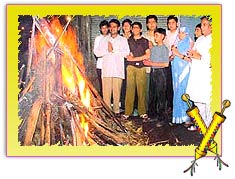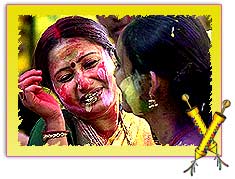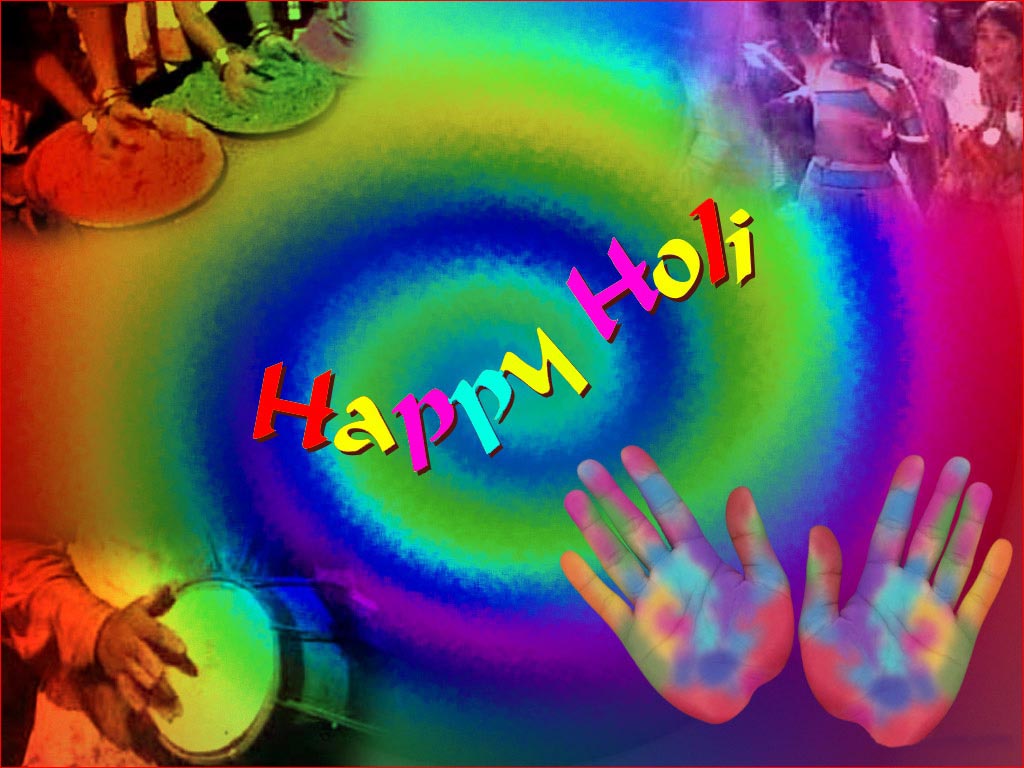One of the major festivals of India, Holi , the festival of colours is celebrated on the full moon day in the month of Phalgun which is the month of March as per the Gregorian calendar.
Preparations
 Entire country wears a festive look. Heaps of various hues of gulal and abeer can be seen shops days before the festival. Pichkaris (to sprinkle colour) come up to drench everybody in colours.
Entire country wears a festive look. Heaps of various hues of gulal and abeer can be seen shops days before the festival. Pichkaris (to sprinkle colour) come up to drench everybody in colours. Women cook loads of gujiya, mathri and papri. At some places specially in the north women also make papads and potato chips at this time.
Season of Bloom
Holi is also called the Spring Festival - as it marks the arrival of spring the season of hope and joy.
Legends
 A Hindu festival, Holi has various legends associated with it. The foremost is the legend of demon King Hiranyakashyap who demanded everybody in his kingdom to worship him but his pious son, Prahlad became a devotee of Lord Vishnu. Hiranyakashyap wanted his son to be killed. He asked his sister Holika to enter a blazing fire with Prahlad in her lap as Holika had a boon which made he immune to fire. Story goes that Prahlad was saved by lord himself for his extreme devotion and evil minded Holika was burnt to ashes, for her boon worked only when she entered the fire alone.
A Hindu festival, Holi has various legends associated with it. The foremost is the legend of demon King Hiranyakashyap who demanded everybody in his kingdom to worship him but his pious son, Prahlad became a devotee of Lord Vishnu. Hiranyakashyap wanted his son to be killed. He asked his sister Holika to enter a blazing fire with Prahlad in her lap as Holika had a boon which made he immune to fire. Story goes that Prahlad was saved by lord himself for his extreme devotion and evil minded Holika was burnt to ashes, for her boon worked only when she entered the fire alone.Since that time, people light a bonfire, called Holika on the eve of Holi festival and celebrate the victory of good over evil and also the triumph of devotion to god. Children take special delight in the tradition and this has another legend attached to it. It says that there was once an ogress DhundhiHolika Dahan'. who used to trouble children in the kingdom of Prithu. She was chased away by children on the day of Holi. Therefore, children are allowed to play pranks at the time of '
Some also celebrate the death of evil minded Pootana. The ogress tried to Lord Krishna as an infant by feeding it poisonous milk while executing the plan of Kansa, Krishna's devil uncle. However, Krishna sucked her blood and brought her end. Some who view the origin of festivals from seasonal cycles believe that Pootana represents winter and her death the cessation and end of winter.
In South India, people worship Kaamadeva- the god of love and passion for his extreme sacrifice. According to a legend, Kaamadeva shot his powerful love arrow on Lord Shiva to revoke his interest in the worldly affairs in the interest of the earth. However, Lord Shiva was enraged as he was in deep mediation and opened his third eye which reduced Kaamadeva to ashes. Though, later on the request of Rati, Kaamadeva's wife, Shiva was pleased to restore him back.
Holika DahanIn South India, people worship Kaamadeva- the god of love and passion for his extreme sacrifice. According to a legend, Kaamadeva shot his powerful love arrow on Lord Shiva to revoke his interest in the worldly affairs in the interest of the earth. However, Lord Shiva was enraged as he was in deep mediation and opened his third eye which reduced Kaamadeva to ashes. Though, later on the request of Rati, Kaamadeva's wife, Shiva was pleased to restore him back.
On the eve of Holi, called Chhoti or Small Holi people gather at important crossroads and light huge bonfires, the ceremony is called Holika Dahan. To render greatfulness to Agni, god of Fire, gram and stalks from the harvest are also offered to Agni with all humility. Ash left from this bonfire is also considered sacred and people apply it on their foreheads. People believe that the ash protects them from evil forces.
Play of Colors

Bright colours of gulal and abeer fill the air & people pour colour water over each other. Children take special delight in spraying colours on one another with their pichkaris and throwing water balloons and passers by. Women and senior citizen form groups called tolis and move in colonies - applying colours and exchanging greetings. Songs, dance on the rhythm of dholak and mouthwatering Holi delicacies are the other highlights of the day.
Expression of Love
Lovers too long to apply colours on their beloved. It is said that the naughty and mischievous Lord Krishna started the trend of playing colours. He applied colour on her beloved Radha to make her one like him. No wonder, there is no match to the Holi of Mathura, Vrindavan and Barsana - the places associated with the birth and childhood of Radha and Krishna.
Ecstasy of Bhang
There is also a tradition of consuming the very intoxicating bhang on this day to further enhance the spirit of Holi.
Sober Evening
After a funfilled and exciting day, the evenings the spent in sobriety when people meet friends and relatives and exchange sweets and festive greetings.
It is said the spirit of Holi encourages the feeling of brotherhood in society and even the enemies turn friend on this day. People of all communities and religions participate in this joyous and colouful festival and strenthen the secular fabric of the nation.
India, we wish you to always be in love and prosperity in flying colours of love for all ...
Unique & peculiar Holi celebrations
Lathmar Holi
the hub of holi in India - Barsana, Holi is known as Lathmaar Holi. The stick is in the hands of the women on this day and the men need to work a lot to save themselves from the immensely charged up womenfolk.
The birth place of Lord Krishna's beloved Radha, Barsana celebrates Holi with extreme enthusiasm as Krishna was famous for playing pranks on Radha and gopis. In fact, it was Krishna who started the tradition of colours by first applying colour on Radha's face.
Men of Nandgaon, the birthplace of Krishna, come to play Holi with the girls of Barsana, but instead of colours they are greeted with sticks. Men come fully padded and try their best to escape from the spirited women. The unlucky ones are forcefully led away and get a good thrashing from the women. Further, they are made to wear a female attire and dance in public. All in the spirit of Holi.
Next day, it is the turn of men of Barsana. They reciprocate by invading Nandgaon and drench the womenfolk of Nandgaon in colours of kesudo, naturally occurring orange-red dye and palash. This day, women of Nadagow beat the invaders from Barsana. It is a colourful site.

